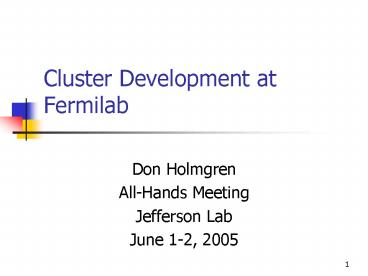Cluster Development at Fermilab - PowerPoint PPT Presentation
1 / 23
Title:
Cluster Development at Fermilab
Description:
Cluster Development at Fermilab Don Holmgren All-Hands Meeting Jefferson Lab June 1-2, 2005 Outline Status of current clusters New cluster details Processors ... – PowerPoint PPT presentation
Number of Views:73
Avg rating:3.0/5.0
Title: Cluster Development at Fermilab
1
Cluster Development at Fermilab
- Don Holmgren
- All-Hands Meeting
- Jefferson Lab
- June 1-2, 2005
2
Outline
- Status of current clusters
- New cluster details
- Processors
- Infiniband
- Performance
- Cluster architecture (I/O)
- The coming I/O crunch
3
Current Clusters (1)
- QCD80
- Running since March 2001
- Dual 700 MHz Pentium III
- In June 2004, moved off of Myrinet and onto a
gigE switch - 67 nodes still alive
- Now used for automated perturbation theory
4
Current Clusters (2)
- nqcd
- Running since July 2002
- 48 dual 2.0 GHz Xeons, originally Myrinet
- 32 nodes now running as prototype Infiniband
cluster (since July 2004) - Now used for Infiniband testing, plus some
production work (accelerator simulation - another
SciDAC project)
5
Cluster Status (3)
- W
- Running since January 2003
- 128 dual 2.4 GHz Xeons (400 MHz FSB)
- Myrinet
- One of our two main production clusters
- To be retired October 2005 to vacate computer
room for construction work
6
Cluster Status (4)
- qcd
- Running since June 2004
- 128 single 2.8 GHz Pentium 4 Prescott, 800 MHz
FSB - Reused Myrinet from qcd80, nqcd
- PCI-X, but only 290 MB/sec bidirectional bw
- Our second main production cluster
- 900 each
- 1.05 Gflop/sec asqtad (144)
- 1.2-1.3 Gflop/sec DWF
7
Cluster Status (5)
- pion
- Being integrated now production mid-June
- 260 single 3.2 GHz Pentium 640, 800 MHz FSB
- Infiniband using PCI-E (8X slot), 1300 MB/sec
bidirectional bw - 1000/node 890/node for Infiniband
- 1.4 Gflop/sec asqtad (144)
- 2.0 Gflop/sec DWF
- Expand to 520 cpus by end of September
8
Details Processors (1)
- Processors on W, qcd, and pion cache size and
memory bus - W 0.5 MB400 MHz FSB
- qcd 1.0 MB800 MHz FSB
- pion 2.0 MB800 MHz FSB
9
Details Processors (2)
- Processor Alternatives
- PPC970/G51066 MHz FSB (split bus)
- AMDFX-55 is the fastest Opteron
- Pentium 640best price /performance for pion
cluster
10
Details Infiniband (1)
- Infiniband cluster schematic
- Oversubscription ratio of nodesuplinks on
leaf switches - Increase oversubscription to lower switch costs
- LQCD codes are very tolerant to oversubscription
- pion uses 21 now, will likely go to 41 or 51
during expansion
11
Details Infiniband (2)
- Netpipe bidirectional bw data
- Myrinet W cluster
- Infiniband pion
- Native QMP implementation (over VAPI instead of
MPI) would boost application performance
12
Details Performance (1) - asqtad
- Weak scaling curves on new cluster
13
Details Performance (2) - asqtad
- Weak scaling on NCSA T2 and FNAL pion
- T2 3.6 GHz Dual Xeon, Infiniband on PCI-X,
standard MILC V6 - pion MILC using QDP
14
Details Performance (3) - DWF
15
Cluster Architecture I/O (1)
- Current architecture
- Raid storage on head node/data/raid1,
/data/raid2, etc. - Files moved from head node to tape silo (encp)
- Users jobs stage data to scratch disk on worker
nodes - Problems
- Users keep track of /data/raidx
- Users have to manage storage
- Data rate limited by performance of head node
- Disk thrashing use fcp to throttle
16
Cluster Architecture I/O (2)
- New architecture
- Data storage on dCache nodes
- Add capacity, bw by adding spindles and/or buses
- Throttling on reads
- Load balancing on writes
- Flat directory space (/pnfs/lqcd)
- User access to files
- Shell copy (dccp) to worker scratch disks
- User binary access via popen(), pread(), pwrite()
ifdefs - User binary access via open(), read(), write()
LD_PRELOAD
17
Cluster Architecture Questions
- Now
- Two clusters, W and qcd
- Users optionally steer jobs via batch commands
- Clusters are binary compatible
- After Infiniband cluster (pion) comes online
- Do users want to preserve binary compatibility?
- If so, would use VMI from NCSA
- Do users want 64-bit operating system?
- gt 2 Gbyte file access without all the defines
18
The Coming I/O Crunch (1)
- LQCD already represents a noticed fraction of
incoming data into Fermilab
19
The Coming I/O Crunch (2)
- Propagator storage is already consuming 10s of
Tbytes of tape silo capacity
20
The Coming I/O Crunch (3)
- Analysis is already demanding 10 MB/sec
sustained I/O rates to robots for both reading
and writing (simultaneously)
21
The Coming I/O Crunch (4)
- These storage requirements were presented last
week to the DOE reviewers - Heavy-light analysis (S. Gottlieb) 594 TB
- DWF analysis (G. Fleming) 100 TB
- Should propagators be stored to tape?
- Assume yes, since current workflow uses several
independent jobs - Duration of storage? Permanent? 1 Yr? 2 Yr?
- Need to budget 200/Tbyte now, 100/Tbyte in
2006 when LTO2 drives are available
22
The Coming I/O Crunch (5)
- What I/O bandwidths are necessary?
- 1 copy in 1 year of 600 Tbytes ? 18.7 MB/sec
sustained for 365 days, 24 hours/day! - Need at least 2X this (write once, read once)
- Need multiple dedicated tape drives
- Need to plan for site-local networks (multiple
gigE required) - What files need to move between sites?
- Configurations assume O(5 Tbytes)/year QCDOC ??
FNAL, similar for JLab (and UKQCD?) - Interlab network bandwidth requirements?
23
Questions?































